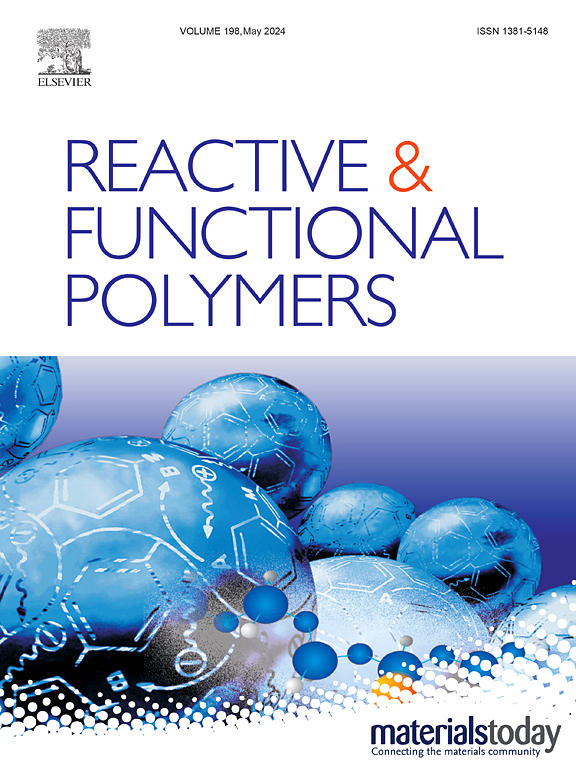利用噻吩基双查尔酮聚合物有效地去除单一组分中的阳离子染料
IF 4.5
3区 工程技术
Q1 CHEMISTRY, APPLIED
引用次数: 0
摘要
本研究探讨了含噻吩的双查尔酮基聚合物[(1E,4E)-1,5-二-2-噻吩五-1,4-二-3 -1](PTCA)和[(1E,4E)-2,4-二甲基-1,5-二(噻吩-2-基)五-1,4-二-3 -1](PTCM)对染料的吸附效果。与甲基红、刚果红、甲基橙等阴离子染料相比,PTCA和PTCM对亚甲基蓝、孔雀石绿、结晶紫、罗丹明B等阳离子染料的去除率更高。由于PTCA和PTCM对结晶紫染料的去除率最高,因此选择PTCA作为代表性阳离子染料,了解影响其吸附的不同因素。实验数据表明,PTCA的最大吸附容量为151.49 mg/g, pcdm的最大吸附容量为142.28 mg/g。吸附数据与Langmuir吸附等温线模型拟合表明为单层吸附。动力学研究表明,吸附遵循准二级动力学,因此化学吸附参与了驱动吸附的过程。对CV的高脱色效率是由于颗粒内扩散过程和表面吸附的共同作用。可回收性研究表明,经过5次循环后,PTCA和PTCM的去除率分别保持在96.42%和92.46%,表明了聚合物吸附剂具有良好的可重复使用性和再生性。本文章由计算机程序翻译,如有差异,请以英文原文为准。

Effective removal of cationic dyes in a single aliquot using thiophene based bis-chalcone polymers
This study explores the dye adsorption efficacy of thiophene bearing bis-chalcone based polymers poly [(1E,4E)-1,5-Di-2-thienylpenta-1,4-dien-3-one] (PTCA) and poly[(1E,4E)-2,4-dimethyl-1,5-di(thiophen-2-yl)penta-1,4-dien-3-one] (PTCM). Both PTCA and PTCM show high removal efficiency towards cationic dyes such as Methylene Blue, Malachite Green, Crystal violet, and Rhodamine B compared to the anionic dyes such as Methyl Red, Congo Red, and Methyl Orange. Since both PTCA and PTCM show the highest removal efficiency towards Crystal Violet dye, it was chosen as a representative cationic dye to understand different factors affecting adsorption. Experimental data indicates that for PTCA, the maximum adsorption capacity observed was 151.49 mg/g and for PTCM, the maximum adsorption capacity observed was 142.28 mg/g. The form-fitting of adsorption data with the Langmuir adsorption isotherm model indicates monolayer adsorption. The kinetic investigation demonstrates that the adsorption follows pseudo second order kinetics, hence chemisorption is involved in the process that drives the adsorption. The high dye removal efficiency towards CV is due to the combined effect of intra-particle diffusion processes and surface adsorption. Recyclability study reveals that PTCA retains 96.42 % removal efficiency and PTCM retains 92.46 % removal efficiency after five cycles, which shows promising reusability and regenerative nature of polymeric adsorbents.
求助全文
通过发布文献求助,成功后即可免费获取论文全文。
去求助
来源期刊

Reactive & Functional Polymers
工程技术-高分子科学
CiteScore
8.90
自引率
5.90%
发文量
259
审稿时长
27 days
期刊介绍:
Reactive & Functional Polymers provides a forum to disseminate original ideas, concepts and developments in the science and technology of polymers with functional groups, which impart specific chemical reactivity or physical, chemical, structural, biological, and pharmacological functionality. The scope covers organic polymers, acting for instance as reagents, catalysts, templates, ion-exchangers, selective sorbents, chelating or antimicrobial agents, drug carriers, sensors, membranes, and hydrogels. This also includes reactive cross-linkable prepolymers and high-performance thermosetting polymers, natural or degradable polymers, conducting polymers, and porous polymers.
Original research articles must contain thorough molecular and material characterization data on synthesis of the above polymers in combination with their applications. Applications include but are not limited to catalysis, water or effluent treatment, separations and recovery, electronics and information storage, energy conversion, encapsulation, or adhesion.
 求助内容:
求助内容: 应助结果提醒方式:
应助结果提醒方式:


